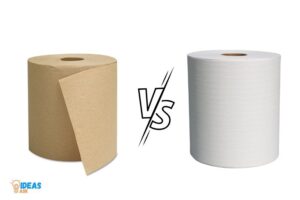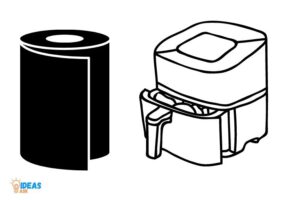When were Paper Towels Invented? 1907 by Arthur Scott
Paper towels were invented in 1907 by Arthur Scott, an employee of the Scott Paper Company in Philadelphia.
The invention of paper towels was a result of a fortunate accident when a railroad car full of paper was mistakenly sent to the Scott Paper Company.
Arthur Scott, trying to find a way to repurpose the paper, decided to cut it into small sheets and sell it as disposable towels.
These towels became popular in public restrooms and eventually in households, leading to the birth of the paper towel industry.
Paper towels have come a long way since their invention in 1907, evolving into an essential and versatile household item.
They are not only used for drying hands and cleaning surfaces but also for various other purposes, such as absorbing grease from fried foods or acting as a makeshift coffee filter.
The paper towel industry has grown significantly and continues to innovate with environmentally friendly and recycled options available for consumers. The invention of paper towels, though accidental, has had a lasting impact on our daily lives.
When were Paper Towels Invented: Year
| Invention | Year |
|---|---|
| Paper Towels | 1907 |
Key Takeaway

Five Facts About Paper Towels
What Are Paper Towels And How Do They Work?
When were paper towels invented: what are paper towels and how do they work?
We’ve all used paper towels at some point in our lives, whether it’s in the kitchen or the bathroom. These multi-functional everyday items help us tackle minor spills and messes, making cleaning up a breeze.
But have you ever wondered how they work or where they came from? We’ll explore the history of paper towels, what they are, and how they work.
Explanation Of What Paper Towels Are And Their Primary Purpose
- Paper towels are absorbent, disposable towels made from paper pulp.
- They are primarily used for cleaning up spills and messes around the home or workplace.
- Paper towels are available in different sizes and thicknesses, with some having added features, like being able to scrub away dirt or having added germ-killing agents.
How Do Paper Towels Work?
- Paper towels are highly absorbent, thanks to the nature of paper pulp, which is made up of fibers that can trap liquid and dirt and hold many times their weight in water.
- When a spill occurs, the porous nature of the fibers allows the liquid to penetrate the towel, making it an effective ‘sponge.’
- The towel can then be thrown away, making them useful for maintaining hygiene and cleanliness.
- Some paper towel brands have added textures or embossing that allows for better wiping, scrubbing, and cleaning.
Paper towels have revolutionized the way we clean up messes and spills. They are simple, effective, and widely available in most homes and public spaces.
By understanding what paper towels are and how they work, we can appreciate their convenience and role in promoting good hygiene practices.
The Early Origins Of Paper Towels
Paper towels are a ubiquitous item in households, offices, and public spaces alike. They are a convenient and disposable way to clean up spills and messes, and they are often used for drying hands.
But have you ever stopped to wonder when paper towels were invented and how they became such a popular household item?
Let’s delve into the early origins of paper towels.
The Creation Of Paper In Ancient China
The creation of paper is believed to have originated in ancient china, where it was made from rice and other plant fibers. This early paper was used for writing and drawing, but it was not until much later that paper began to be used for cleaning and wiping.
The Development Of Papermaking In The Middle East And Europe
Papermaking spread from china to the middle east and europe, where it was refined to create a stronger and more durable product. By the middle ages, paper was being used for a variety of purposes, including cleaning and wiping.
The Invention Of The First Disposable Paper Towels In The Early 1900S
The first disposable paper towels were invented by arthur scott in philadelphia in the early 1900s. Scott was the head of a paper company that was looking for ways to use up the paper ends that were cut off during the manufacturing process.
He came up with the idea of creating disposable paper towels, which could be used for cleaning and then thrown away.
- The first paper towels were thick and absorbent, and they were marketed to businesses such as hotels and restaurants.
- By the 1920s, paper towels had become popular in households as well, and they were increasingly used for wiping up spills and messes.
- In the decades that followed, paper towels became even more convenient and practical as they were made thinner and smaller, with perforations that made them easy to tear off.
- Today, paper towels are an essential household item that we often take for granted. They are available in a wide variety of sizes, colors, and designs, and they continue to be one of the most popular and convenient ways to clean up spills and messes.
Overall, the history of paper towels is a fascinating example of how a simple household item can evolve over time to meet the changing needs and preferences of people.
From its humble origins in ancient china to its modern-day form, the paper towel has become an essential part of our daily lives.
The Rise Of Paper Towels In America
Paper towels are a ubiquitous household item today, but it wasn’t always the case. The invention of paper towels dates back to the early 1900s, but it wasn’t until the 1950s that it gained widespread popularity in america.
We explore the rise of paper towels in the us, and the factors that contributed to their popularity.
The Impact Of Advertising On The Popularity Of Paper Towels
Advertising played a crucial role in boosting the popularity of paper towels in america.
Scott paper company, a major player in the paper industry, launched a major marketing campaign in the 1920s, promoting their paper towels as a hygienic and disposable alternative to cloth towels.
They used print ads, billboards, and radio commercials to reach consumers, creating a need where previously there was none.
- Paper towels were marketed as a cleaner and more convenient option than cloth towels, which were used for various purposes.
- Scott paper company’s ads were placed in newspapers, magazines, and radio commercials, and prominently featured their brawny man mascot.
- Advertisements also emphasized the absorbent properties of paper towels, and how easy they were to dispose of.
The Role Of World War Ii In Promoting Disposable Paper Products
The onset of world war ii led to a shortage of resources, including cotton, which was used to make cloth towels. This created a need for disposable paper products, which were increasingly popularized during this era.
Manufacturers of paper products stepped up their production, leading to increased usage of disposable paper items in place of more traditional cloth options.
- Cotton scarcity and the need for disposable products during wwii helped promote the use of paper towels and other disposable products.
- Due to the scarcity of cotton, cloth products such as towels, rags, and mop heads were no longer widely available, which created a need for paper alternatives.
- Manufacturers, such as kimberly-clark, seized the opportunity and increased their production of disposable paper products, including paper towels.
The Introduction Of Modern, Absorbent Paper Towels In The 1950S
The 1950s saw the introduction of modern, absorbent paper towels that were superior to their predecessors.
These paper towels were more durable, more absorbent, and less likely to tear. This increased functionality and convenience led to paper towels becoming a staple in american households.
- In the 1950s, paper towels were made with a wood pulp and bonded cellulose material that was stronger and more absorbent than previous iterations.
- Manufacturers like scott paper company, charmin, and cottenelle invested heavily in research and development of their paper towels, innovating to create a more durable and absorbent product.
- The introduction of modern, absorbent paper towels led to the rise in popularity that made them a household item across america.
Paper towels have come a long way since their first invention in the early 1900s. From humble beginnings, they have become a household essential in many american homes.
Factors such as advertising, a need for disposable products during war times, and technological innovations have contributed to the rise of paper towels in america.
Innovation And Improvements In Paper Towel Technology
When Were Paper Towels Invented?
Paper towels are now a household staple, becoming a crucial item in maintaining cleanliness and personal hygiene.
The invention of paper towels dates back to the early 1900s, an accidental discovery by arthur scott, ceo of scott paper company.
In the beginning, the paper towels didn’t become an instant success until further advancements were made.
The Introduction Of Multi-Ply Paper Towels
The first version of paper towels was made with a single-layer of paper, incapable of soaking up a significant amount of liquids.
It wasn’t until 1931 when the concept of multi-ply paper towels was introduced, doubling and tripling layered sheets to create more absorbency.
Here are some key points surrounding the introduction of multi-ply paper towels:
- Multi-ply paper towels use multiple layers of paper, offering a higher level of absorbency than its single-layered counterparts.
- Use of multi-ply paper towels is common in modern household economics, offering convenience and easy use.
- Multi-ply paper towels are more durable and resistant to tearing, making them better suited for heavy-duty tasks.
The Development Of Embossed And Quilted Textures
After the introduction of multi-ply paper towels, scott paper company kept improving the paper towel technology.
The introduction of embossed and quilted textures aims to increase the surface area of the paper towel, improving the absorbency rate.
Here are some bullet points about the development of embossed and quilted textures:
- Embossing provides a more robust and textured surface to increase the absorbency rate of paper towel.
- Quilting refers to the unique design that includes a type of diamond or square pattern, creating pockets for liquids to be absorbed.
- These technologies can reduce the amount of paper towels used and are available in eco-friendly options.
The Use Of Recycled Materials In Eco-Friendly Paper Towel Options
As awareness concerning environmental preservation increases, so have clients’ demands for sustainable and eco-friendly products, including paper towels.
The innovation of recycled paper towel is in direct response to this demand, producing paper towels that are free from harsh chemicals and made from recycled materials.
Here are some key points surrounding the use of recycled materials in eco-friendly paper towel options:
- The principle of eco-friendly paper towels is that they’re both recyclable and made from recycled materials.
- They come packaged in biodegradable materials to help reduce waste in landfills.
- Buying eco-friendly, recycled paper towels can make a profound and positive environmental impact, promoting the production of sustainable items.
We hope the information above provided a comprehensive overview of the innovation and improvements in paper towel technology, particularly as they pertain to multi-ply paper products, embossed and quilted textures, and eco-friendly, recycled materials.
Knowing about the technology and sustainability of paper towels can help consumers make more informed choices on the products they use daily.
FAQ On Paper Towels
What Year Were Paper Towels Invented?
Paper towels were invented in 1907 by arthur scott, who was looking for a new use for rejected toilet paper.
How Do Paper Towels Work?
Paper towels are made of absorbent materials, such as cellulose, which quickly soak up liquids and can be thrown away after use.
What Did People Use Before Paper Towels?
Before paper towels, people used cloth towels or rags that had to be washed and reused, which was not always convenient or sanitary.
Can You Recycle Paper Towels?
Unfortunately, paper towels cannot be recycled due to their mixed material composition and potential for contamination with food waste. They should be composted instead.
Conclusion
The invention of paper towels has touched the lives of millions of people worldwide. From the early days of cooking to cleaning up spills and messes, every home today has a stack of paper towels in their kitchen or bathroom.
The history of paper towels is quite fascinating, and it’s incredible to see how much they have evolved over the years, from a simple invention to a product that is now a staple in every household. The invention of paper towels revolutionized the hygiene industry and provided a solution to a problem that people were facing daily.
Even today, the demand for paper towels continues to grow, and with the advancements in technology, we can expect better and more improved versions of this product in the future. This incredible invention is a testament to the ingenuity and innovation of human beings, and it continues to be a useful household utility that we rely on every day.






